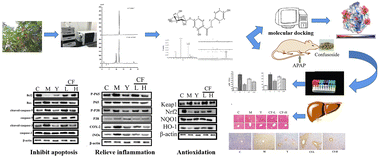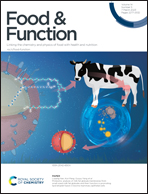Confusoside, a dihydrochalcone glucoside, prevents acetaminophen-induced liver injury by modulating the Nrf2/NF-κB/caspase signaling pathway†
Abstract
Dihydrochalcones are important bioactive ingredients in plants. Anneslea fragrans is an edible and medicinal plant, and its leaves are rich in dihydrochalcones. Confusoside (CF) is the most abundant dihydrochalcone in A. fragrans leaves, which is traditionally used in the treatment of liver diseases. The aim of this study was to investigate the hepatoprotective effect of CF on acetaminophen (APAP)-induced hepatic injury in mice. CF could reduce the levels of AST, ALT, and LDH in the serum and enhance the antioxidant activity by activating the Nrf2 signaling pathway to increase the activities of antioxidant enzymes (SOD and CAT), and the GSH content but decrease the MDA accumulation in liver tissues. Immunofluorescence assay and western blotting analysis showed that CF can regulate Nrf2 into the cell nucleus, thereby promoting the expression of downstream antioxidant-related proteins, including NQO1 and HO-1. In addition, CF could inhibit the liver inflammatory response by suppressing the activation of the NF-κB signaling pathway to reduce the expressions of TNF-α, IL-1β, IL-6, and NO. Molecular docking results showed that there was good binding between the CF and Keap1-Nrf2 protein. Western blotting and TUNEL analysis also revealed CF-inhibited cell apoptosis-related protein expression (Bcl2 and caspase-3/9 proteins). Thus, the CF from A. fragrans leaves could be served as an alternative hepaprotective agent for the treatment and prevention of APAP-induced liver injury.



 Please wait while we load your content...
Please wait while we load your content...